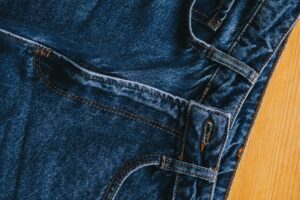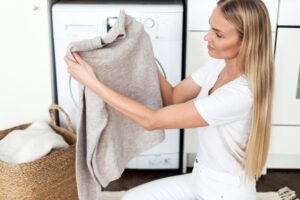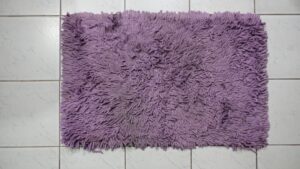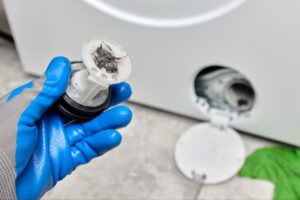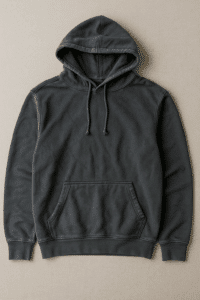How to Wash Stuffed Animals
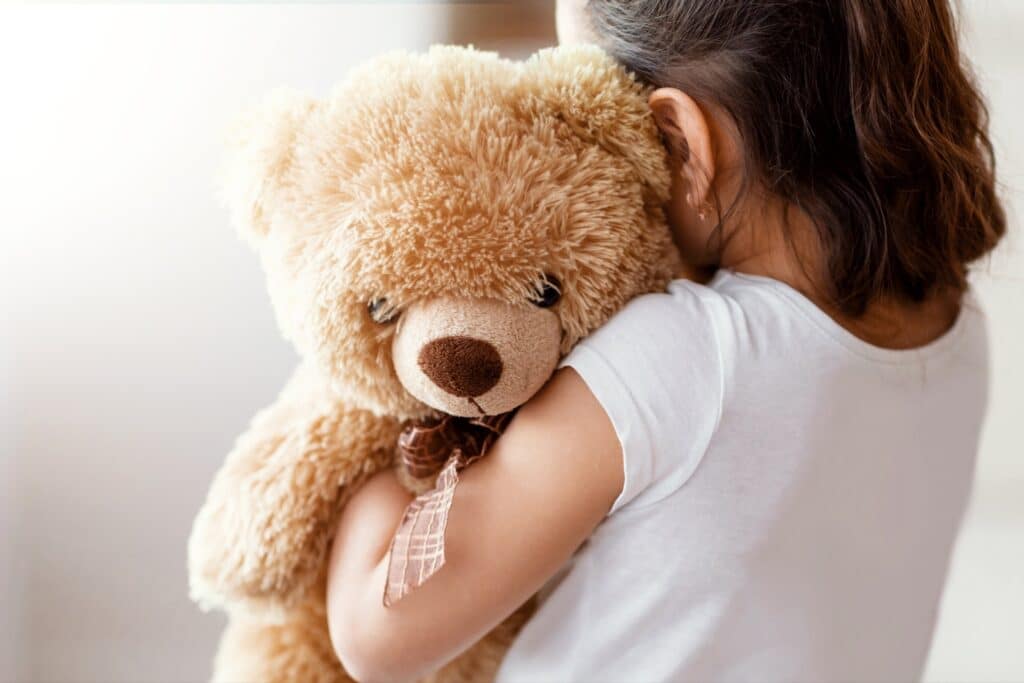
There’s nothing like a beloved stuffed animal – until it starts smelling funky or looking a little grungy. If you’re wondering how to wash stuffed animals without ruining their cuddly charm, don’t worry. Most plush toys can be cleaned at home safely, and we’re here to guide you through it in a friendly, time-saving way. From machine washing to hand washing, and tackling delicate or electronic toys, we’ll explain the best methods to keep your child’s favorite “stuffie” fresh and snuggle-ready.
How often to wash stuffed animals
Plush toys might not need a weekly wash like your clothes, but they do collect dust, dirt, and germs over time. Experts recommend cleaning stuffed animals weekly if they’re constant bedtime companions or carried everywhere, and about once a month for toys that get lighter use. Always wash them right away if they’ve been spilled on, dragged through mud, or cuddled during an illness. Regular cleaning not only protects your little one from germs and allergens, it also helps these treasured friends last longer.
Check the care label and fabric
Before washing any stuffed animal, start by checking its care tag (if available). The tag may tell you whether machine washing is safe or if the toy is “surface wash only.” Can you wash stuffed animals in a washing machine? Yes – most newer stuffed animals can handle a gentle machine wash, but there are some exceptions. If the toy is very old, extremely delicate, or has glued-on decorations (like sequins, glued eyes, or felt pieces), you’ll want to avoid the washer and opt for hand washing or spot cleaning to be safe. Similarly, any plush with a built-in battery box, music player, or electronic wires should not be fully submerged in water, as water can damage the electronics. In those cases, stick to surface cleaning (more on that below).
It’s also wise to do a quick colorfastness test before the first wash, especially if the stuffed animal is brightly colored or vintage. Dampen a white cloth with a bit of mild detergent and water, and gently rub a hidden area of the fur or fabric. If you see color transfer onto the cloth, it’s better not to machine wash – use cold water and gentle hand cleaning only (or just spot clean) to prevent colors from bleeding.
How to wash stuffed animals in the washing machine
Machine washing is the easiest and most effective way to deep-clean stuffed toys – as long as they’re sturdy enough for it. Washing stuffed animals in the washing machine not only saves you time, it also gives them a thorough sanitizing scrub. Here’s how we recommend machine washing your child’s favorite plush friend:
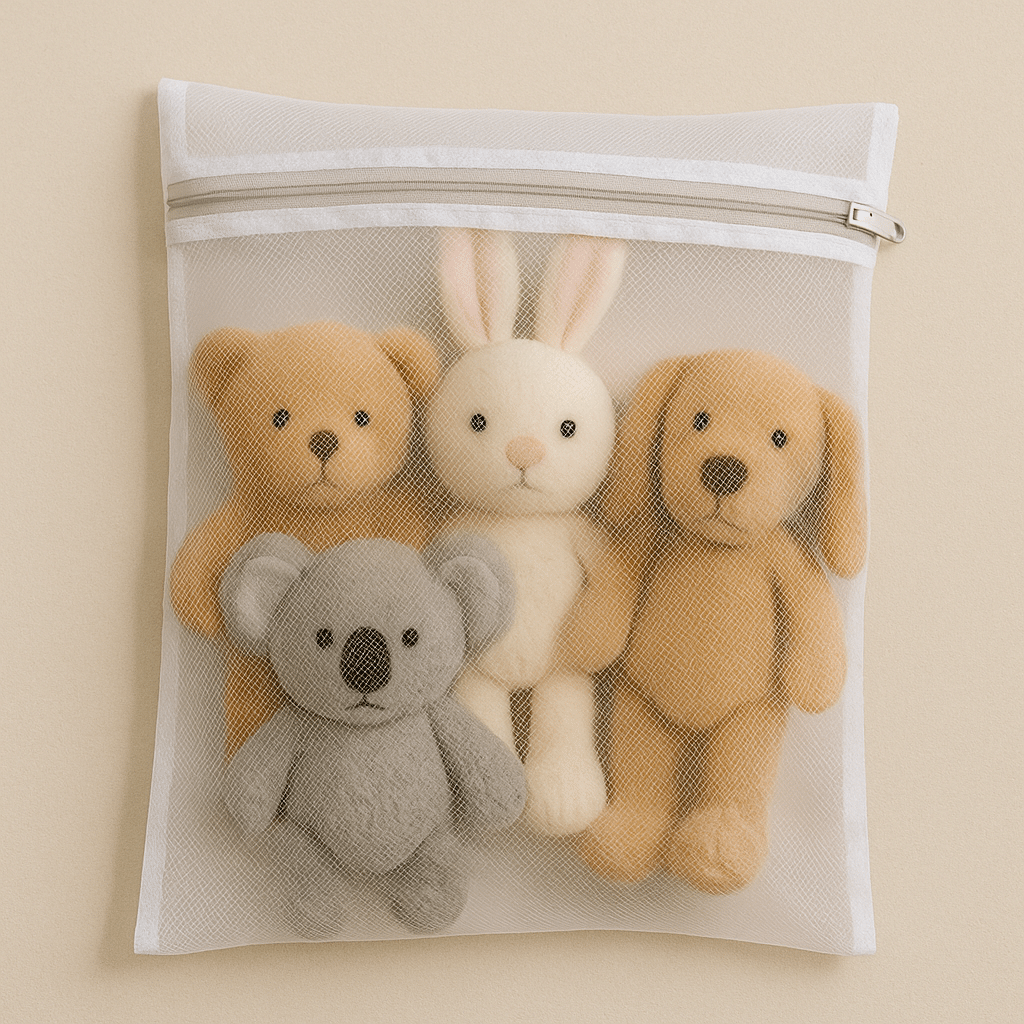
1. Prep and protect the plush. First, remove any loose accessories or outfits on the stuffed animal (like a doll’s clothing or removable parts). If there are any obvious stains, pre-treat them by gently blotting with a mild stain remover or a bit of liquid detergent on a damp cloth. Next, place the stuffed animal in a protective mesh laundry bag or zippered pillowcase. This step is key to prevent straps, fur, or limbs from snagging or stretching during the wash cycle. (No mesh bag on hand? A clean pillowcase tied shut will do.) It’s also a good idea to wash the toy with a few other soft items – for example, add some towels – to cushion it during the wash.
2. Choose gentle settings and mild detergent. Wash stuffed animals on your machine’s gentle or delicate cycle, using cold water. A cold, gentle wash is easier on fabrics and colors (hot water could cause dyes to run or parts to melt). Add a small amount of mild laundry detergent – ideally fragrance-free or a detergent formulated for baby clothes. Avoid bleach or harsh chemicals, which can be rough on fur and fabric. If your washer has an extra rinse option, use it to ensure all soap is out (especially important for toys that will be snuggled by kids with sensitive skin).
3. Sanitize as needed. If you want to be extra sure the toy comes out germ-free, you can add a laundry sanitizer to the wash. A product like Lysol Laundry Sanitizer (which is designed to kill 99.9% of bacteria even in cold water) can be poured into the fabric softener dispenser or added during the rinse cycle. This lets you sanitize without resorting to hot water.
4. Air dry thoroughly. After washing, take the stuffed animal out of the bag and gently squeeze or press out excess water with a towel. The safest drying method is to let it air dry. High heat from a dryer can damage plush toys by melting plastic details or loosening glue, so avoid the dryer unless the care label explicitly says it’s okay. (Even then, we recommend only a low-heat, short tumble in a pillowcase or mesh bag.) Find a well-ventilated area to lay out or hang the stuffed animal. You might set it on a drying rack or even near a fan to speed things up. To help fluff the toy as it dries, you can gently shake it out or use a hair dryer on a cool setting. Patience is key – your clean pal might take a day or two to fully dry, but making sure it’s dry all the way through will prevent mildew.
How to hand wash stuffed animals
Hand washing is the way to go for stuffed animals that are a bit more fragile – or any toy you’re not comfortable putting in the washer. It’s also the best method for older teddy bears that might be loosely stitched or for toys with parts that might fall off in a machine. Here’s how to gently hand wash a stuffed animal:
1. Remove batteries or electronics. If the toy has a battery compartment or any electronic device inside, remove those components first (if possible). For music boxes or voice boxes that can’t be taken out, you’ll have to keep that part dry – consider spot cleaning only, since submerging an electronic toy is risky. (Never immerse a toy with batteries still inside.) For electronic sections you can’t remove but want to protect during a hand wash, you can try wrapping the battery box in plastic wrap and tape to shield it – but again, if in doubt, stick to surface cleaning that part.
2. Fill a basin with cool soapy water. In a clean sink or tub, mix lukewarm or cool water with a small amount of mild detergent. Just a teaspoon or two of detergent in a gallon of water works – you want a sudsy, gentle solution. Swish the water to dissolve the soap. Avoid using hot water, which could dissolve glues or leach out colors.
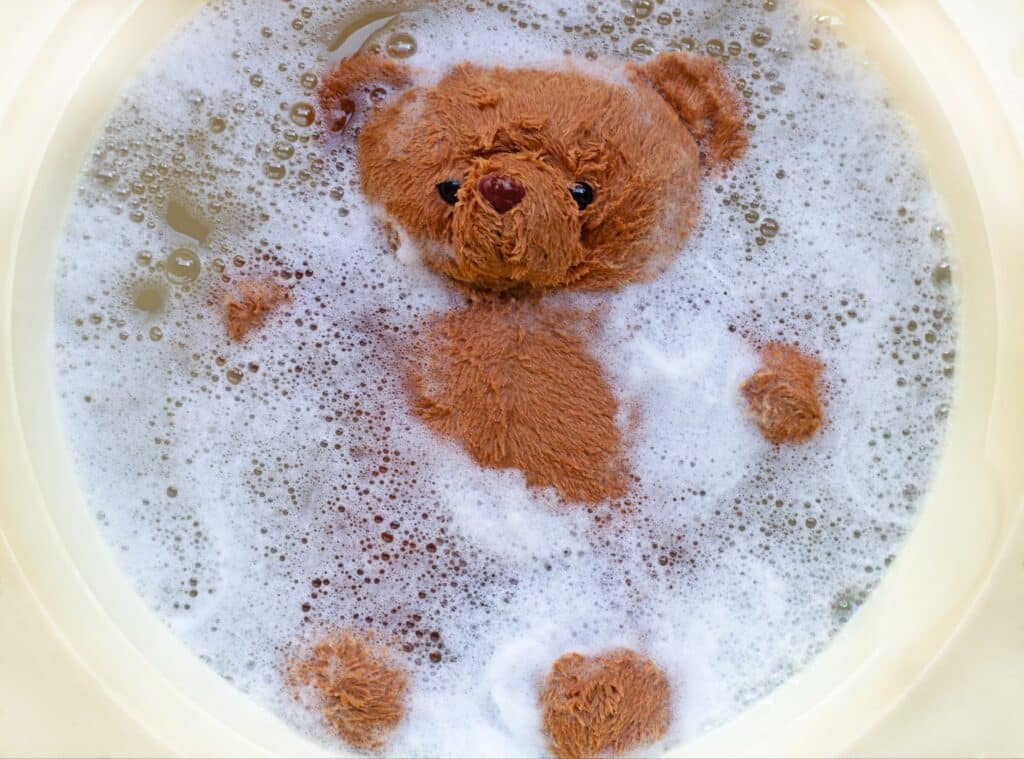
3. Gently wash and rinse. Submerge the stuffed animal (or the parts of it that are washable) into the water. Use your hands to gently squeeze water through the plush, cleaning it without harsh scrubbing. Pay extra attention to any soiled spots – you can rub those lightly with your fingers or a soft cloth. Be gentle, especially if the toy has sewn-on parts or is old. Once it seems clean, drain the soapy water and refill the basin with plain rinse water (cool). Squeeze the toy under the clean water to rinse out soap. You may need to do this twice with fresh water until no suds remain. Remember not to wring or twist the stuffed animal, as that can misshape the filling; instead, press and squeeze gently to push out the soapy water.
4. Towel dry and air dry. Lift the toy out and support its weight – wet stuffed animals can be heavy and you don’t want to strain any seams. Lay it on a thick towel and roll it up lightly to blot out water. You can also press the towel against it to soak up moisture. Then lay the toy out to air dry completely. Just like with machine-washed toys, find a ventilated spot and give it plenty of time. Ensure the inner stuffing dries out (this can take over 24 hours). For faster drying, placing it near a fan or using a hair dryer on cool setting helps. Don’t rush with heat – high heat can shrink fabric or ruin fur. And wait until it’s 100% dry before giving it back to your child or before re-inserting any batteries.
Spot cleaning and odor removal for non-washable toys
What about stuffed animals that can’t be immersed in water at all? Some toys – think vintage collectibles, those filled with foam beads, or any with delicate glued features – should not be soaked. In these cases, spot cleaning is your best friend. To spot clean a stuffed animal, mix a small bowl of cool water with a drop of gentle detergent. Dampen a clean white cloth in the soapy water (it should be slightly wet, not dripping). Gently blot and wipe the areas that are dirty, being careful not to saturate the fabric. This method lifts surface dirt and minor stains. Afterward, go over the same areas with another cloth dampened in plain water to remove any soap residue. Finally, let the toy air dry.

If you’re dealing with a musty or smelly stuffed animal that you can’t wash fully, try a simple deodorizing trick: the baking soda method. Place the plush toy in a large plastic bag (a garbage bag works) along with about 1/2 cup of baking soda. Close the bag and give it a good shake for a minute or two, making sure the baking soda distributes through the fur. Let it sit for a few hours or overnight – the baking soda will absorb odors and oils from the toy’s surface. Afterwards, take the toy out and shake it well to knock off as much powder as possible. You can use a vacuum with a brush attachment to gently vacuum the toy and remove remaining baking soda. This “dry cleaning” at home freshens the stuffed animal without any water.
Another non-wash method to sanitize a stuffed animal is to use your freezer. Yes, freezing a plush toy can help kill germs and dust mites. Seal the toy in a plastic bag and leave it in the freezer for 24 hours. While this won’t remove stains, it’s a handy way to disinfect a toy that you can’t wash (for instance, a beloved teddy that your child slept with while sick). Once you take it out of the freezer, let it come back to room temperature and give it a thorough vacuum or shake-out to remove any dead dust mites.
Light steaming is also an option for surface sanitizing. You can use a garment steamer or the steam setting on an iron (held a short distance away) to steam the plush. The heat will kill many germs and help release odors. Just be cautious with very delicate or glued-on parts, as heat can loosen adhesives. Always test a small area first if you try steaming.
Drying and final touches

We’ve said it before, but it bears repeating: air drying is the safest way to dry a stuffed animal. Tumble drying is generally not recommended for plush toys, since high heat and tumbling can be too rough. Even so, some modern stuffed animals do fine with a brief low-heat tumble dry (especially if protected in a pillowcase). If you choose to machine dry, use the lowest heat setting and check the toy frequently. Adding a couple of dry towels can help fluff the toy and reduce static. But when in doubt, stick to line drying or laying the toy flat.
Once the stuffed animal is dry, give it a good look-over. You can use a soft brush (like a clean toothbrush or pet brush) to gently brush out the fur and restore fluffiness. Reshape any misshapen parts by hand – often a bit of massaging of the stuffing will get arms and ears back in position. If any small parts like eyes or ribbons came loose in washing, reattach or tighten them securely before returning the toy to your child.
After cleaning, your child’s favorite friend should look and smell much better! To keep them that way, try to spot clean spills when they happen and store stuffed animals in a clean, dust-free place when not in use. If a toy is being shelved for a long time (for example, saved as a keepsake), consider wrapping it in tissue paper or a pillowcase to protect it from dust. Regular TLC will make big washings needed less often.
Professional help for tricky toys
Most of the time, home washing will do the job. But if you’re dealing with a very valuable stuffed animal or you just don’t have the time, professional laundry services are a neighbor-approved solution. We’re clean-obsessed at Spincycle, and we’ve handled everything from everyday laundry to delicate teddy bears. Our wash-and-fold service can save you the chore of washing stuffed animals – just drop them off and we’ll return them fresh, fluffy, and ozone-sanitized. (We use an ozone laundry system to disinfect items without harsh chemicals, which is perfect for children’s toys.) If you prefer to do it yourself but lack a gentle washer or have a heap of stuffed friends to clean, check out our self-service laundry facilities – our high-capacity machines are made for bulky loads and tough jobs.
In short, knowing how to wash stuffed animals means you can keep your kids’ cuddle buddies clean and safe. With the tips above, you’ll wash, dry, and deodorize each plush with confidence. And when in doubt, or when that giant teddy just won’t fit in your home washer, remember we’re here to help. After all, every child (and parents too) deserves clean, huggable toys – and a little extra free time for storytime wouldn’t hurt either. For more tips on cleaning those other fluffy items in your home, you can also read our guide on how to wash pillows. Here’s to keeping things clean, with less stress and more playtime.

